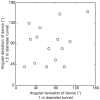The dung beetle dance: an orientation behaviour?
- PMID: 22279572
- PMCID: PMC3261170
- DOI: 10.1371/journal.pone.0030211
The dung beetle dance: an orientation behaviour?
Abstract
An interesting feature of dung beetle behaviour is that once they have formed a piece of dung into a ball, they roll it along a straight path away from the dung pile. This straight-line orientation ensures that the beetles depart along the most direct route, guaranteeing that they will not return to the intense competition (from other beetles) that occurs near the dung pile. Before rolling a new ball away from the dung pile, dung beetles perform a characteristic "dance," in which they climb on top of the ball and rotate about their vertical axis. This dance behaviour can also be observed during the beetles' straight-line departure from the dung pile. The aim of the present study is to investigate the purpose of the dung beetle dance. To do this, we explored the circumstances that elicit dance behaviour in the diurnal ball-rolling dung beetle, Scarabaeus (Kheper) nigroaeneus. Our results reveal that dances are elicited when the beetles lose control of their ball or lose contact with it altogether. We also find that dances can be elicited by both active and passive deviations of course and by changes in visual cues alone. In light of these results, we hypothesise that the dung beetle dance is a visually mediated mechanism that facilitates straight-line orientation in ball-rolling dung beetles by allowing them to 1) establish a roll bearing and 2) return to this chosen bearing after experiencing a disturbance to the roll path.
Conflict of interest statement
Figures


References
-
- Bartholomew GA, Heinrich B. Endothermy in african dung beetles during flight, ball making, and ball rolling. J Exp Biol. 1978;73:65–83.
-
- Cheung A, Zhang S, Stricker C, Srinivasan M. Animal navigation: the difficulty of moving in a straight line. Biol Cybern. 2007;97:47–61. - PubMed
-
- Rossel S, Wehner R. How bees analyse the polarization patterns in the sky. J Comp Physiol A. 1984;154:607–615.
-
- Ugolini A. Equatorial sandhoppers use body scans to detect the earth's magnetic field. J Comp Physiol A. 2006;192:45–49. - PubMed
Publication types
MeSH terms
LinkOut - more resources
Full Text Sources
Medical
Miscellaneous

